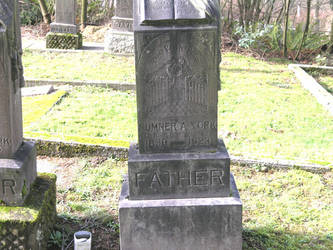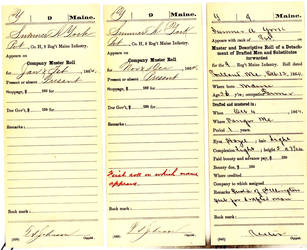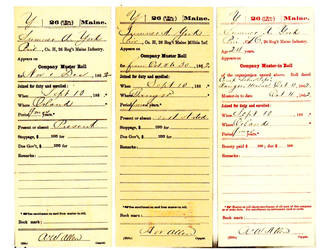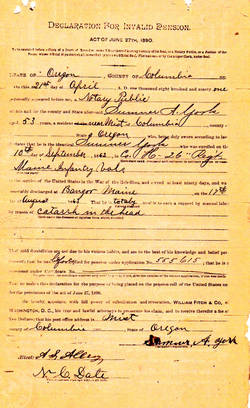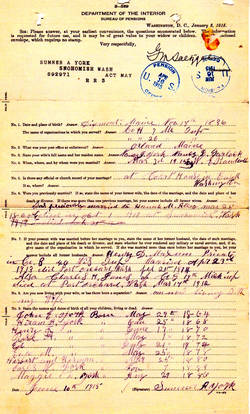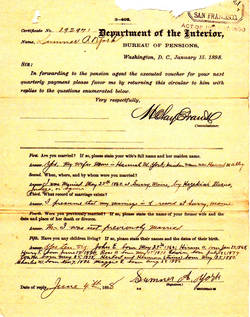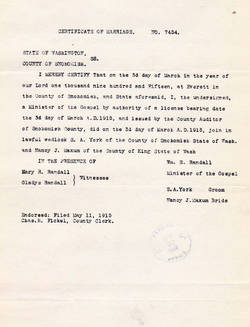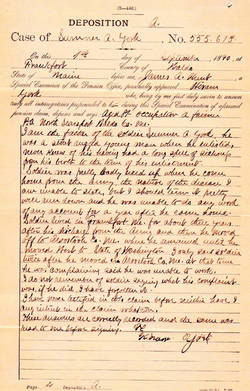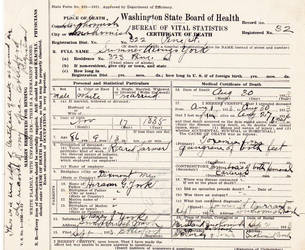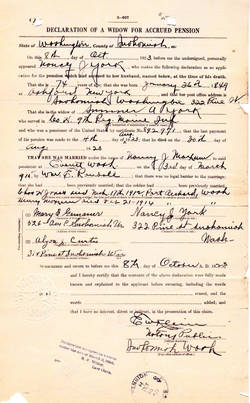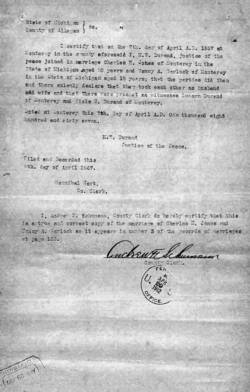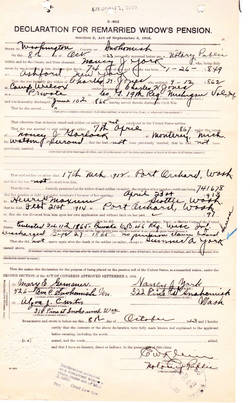Full Unit History
26th MAINE VOLUNTEER INFANTRY
Organized: Summer/Fall, 1862 Camp John Pope Bangor, ME
Mustered In: 10/11/62 Camp John Pope Bangor, ME
Mustered Out: 8/9/63 Bangor, ME
9th MAINE VOLUNTEER INFANTRY
Organized: Summer, 1861 Augusta, ME
Mustered In: 9/22/61 Augusta, ME
Mustered Out: 7/13/65 Raleigh, NC
Discharged: No Date Avail., Augusta, GA
Regimental History
REGIMENTAL HISTORY: (26th)
The 26th has somewhat of an interesting history due to the fact that while it was reportedly mustered in to Federal service for a period of three years, it served only nine months. As all information pertaining to the regiment emphasizes a nine month period of service, unless one studying the makeup of this regiment was aware of the 3 year/9 month discrepancy, one would assume it was always to have been a 9 month regiment from inception to final muster. Why this 3 year/9 month service period was the case is not known.
The 26th had another claim to fame within its short period of existence. If one considers its first few months of service being in Washington City and the final months in Louisiana, the regiment served in both eastern and western theaters of the American Civil War.
Raised in the counties of Knox, Hancock and Waldo, the 26th was rendezvoused at Camp John Pope located in Bangor, ME. From there it left the state on 10/23 and arrived in Washington, D.C. on the 27th. On 11/9 it moved to Fortress Monroe in Virginia. From there it re-embarked 12/1 from nearby Newport News on the steamers Pocahontas and Maratanza bound for New Orleans, LA where it arrived on 12/16. From there it moved to Baton Rouge and remained there until 3/12/63.
In March, 1863 the 26th briefly joined the Union movement upon Port Hudson then returned to Baton Rouge in order to embark for Donaldson, some sixty miles below, aboard the steamer St. Maurice. It then moved to Thibodeaux and by rail to Brashear City. On 4/11 it travelled to Irish Bend near Franklin, LA where it engaged the enemy and met with a loss of 68 men out of 300 engaged.
On 5/30/63 the regiment arrived at Port Hudson, LA and engaged in supporting a battery until 6/14 when it participated in the assault of that day, afterward returning to its former position. On the surrender of Port Hudson it remained on duty at that place until moving northward for final muster.
Regimental losses: Officers killed or mortally wounded: 0; Officers died of disease, accidents, etc.: 1; Enlisted men killed or mortally wounded: 34; Enlisted men died of disease, accidents, etc.: 130.
REGIMENTAL HISTORY: (9th)
The 9th Maine, a three year, western theater regiment was raised from throughout the state at large and organized at Augusta. Less than two weeks from the arrival of the first company at Augusta it was on its way to Washington City. Arriving at that place it was assigned to an expedition headed south to capture Port Royal, SC. Landing at Hilton Head, SC on 11/8/61, the following February it moved off the coast of Georgia and then helped capture Fernandina, FL. It remained in the latter location until 1/17/63 when it returned to Hilton Head. From there it moved to St. Helena Island as part of a force preparing to assault Morris Island’s Fort Wagner, a Rebel earthen fort made famous by the 1989 movie Glory.
On 7/10 the regiment landed on Morris Island where it carried the enemy's rifle pits in front of Fort Wagner. During the several assaults on the fort which took place 7/11, 7/18 and 9/6 the 19th lost over three hundred men killed, wounded or missing. It would remain on Morris Island and Black Island beyond mid-April, 1864.
In the spring of 1864 the 19th departed South Carolina and moved northward to Virginia's Bermuda Hundred. From this time on until the end of the war the regiment saw much hard service in front of Petersburg and Richmond, VA participating in the following engagements: Drewry's Bluff, Bermuda Hundred, Cold Harbor, Deep Bottom, Fort Gilmer, Darbytown Road, and Chaffin's Farm.
1865. With the fall of Fort Fisher, NC on 1/15/1865, the unit was ordered back south, proceeding to Raleigh, NC which it entered on 4/11. It remained at Raleigh until final muster.
Regimental Losses: 10 officers killed or mortally wounded; 3 officers died of disease, accidents, etc.; 172 enlisted men killed or mortally wounded; 236 enlisted men died of disease, accidents, etc.
Soldier History
SOLDIER: (26th)
Residence: Orland, ME Age: 26.10 yrs.
Enlisted/Enrolled: 10/11/62 Rank: Pvt.
Mustered In: 10/11/62
Mustered Out: 8/17/63 Bangor, ME
Discharged: Inf. Not Avail.
Highest Rank: Pvt.
SOLDIER: (9th)
Residence: Dixmont, ME Age: 27.10 yrs.
Enlisted/Enrolled: 10/4/64 Rank: Pvt.
Mustered In: 10/4/64 (as substitute)
Mustered Out: 7/13/65 Raleigh, NC
Discharged: No Date Avail., Augusta, GA
Highest Rank: Pvt.
Family History
PERSONAL/FAMILY HISTORY:
As best as can be determined, Sumner Alonzo York was born 11/17/36 in Dixmont, Penobscot Co., Maine. Interestingly, it was not until years later as an adult completing paperwork in order to obtain a government disability pension based on time spent in the U.S. Army during the American Civil War that he learned that, in fact, his birth year had been 1836. More on this later.
Sumner's father was Hiram Oliver York (b. ca. 1803/'09), a farmer. His mother was Jerusha (nee Stephens b. 1811) York. Children by Hiram and Jerusha were Benjamin (b. 1833 ME), Philo J. (b. est. 1834 ME), [Note: Family historians are divided on whether or not Ben and Philo were twins.]Sumner and twins Hiram Granville and Jerusha Ellen/Ellen Jerusha “Ella” (b. 12/12/40 ME). According to family lore, Jerusha died giving birth to the brother/sister twins.
Following Jerusha’s death Hiram O. remarried to Martha “Patty” Wright (b.1817). Children by Hiram and Patty were Martin Van Buren (b. 1842 ME) and Sally (b. 1847 ME).
The fate of Patty York is not known. What is known is that Hiram O. married for a third time to wife Eliza Clark (b. 1815). From this union came three additional York children: Herbert Oliver (b. 1856 ME), Ruby Ann (b. 1857 ME) and Wilbert S. (b. 1862 ME).
While Sumner was born in Dixmont, Maine, it appears that by 1855 or'56 the family had relocated to the Waldo County Maine community of Frankfurt. When and why that move had occurred is not known. Sumner reportedly resided there with his birth family until shortly after the 1860 U.S. Census when he married and established a household of his own.
Sumner’s marriage took place on 5/25/60, in Surry (co.) Maine His bride was Hannah Margaret Alley (b. 4/22/39 Sagadahoc Co., ME). The marriage was a first - and last- for both.
Following their wedding Sumner and Margaret appear to have set up their home in Orland (Co.), ME. There, they began a family which would encompass at least ten children. Before this, however, there was a war to be fought.
In October, 1862 Sumner, who had been employed in local sawmills, left his bride and home to enlist in the U.S. Army for a period of nine months. His unit of service was the Company "H" of the 26th Maine Infantry. The motivation for enlistment, whether it was patriotism, financial gain or something other is not known. Over all, with the exception of physical ailments his period of service would be fairly benign.
Sickness-wise, during the first two weeks of December Private York was aboard the steamer Maratanza moving between Fortress Monroe, VA and New Orleans. During this two week period he appears to have experienced kidney problems which caused cessation of his body's ability to urinate. For this otherwise undiagnosed condition he sought assistance from a surgeon (doctor) and was given some unknown medication which apparently solved the problem.
After arriving in New Orleans, sometime during either late 1862 his regiment moved from that location to Baton Rouge also in Louisiana. At that place he contracted a case of the measles which lead to his hospitalization for approximately one week before being returned to duty. The disease would have long lasting consequences, however, as it would weaken his eyesight and cause him difficulty reading fine print for the rest of his life. Finally, two weeks prior to his August mustering out and discharge he began experiencing bowel troubles - a common ailment amongst Civil War era servicemen -which would follow him back to Maine before fading away.
Once he was back home in Maine, it is unclear if Sumner tried to return to work in the sawmill and found he could no longer handle the burden of such employment or if that epiphany came later, after his second period of enlistment. Yes, there was a second enlistment. More on this shortly.
Sumner and Hannah welcomed their first child - son John - into this world on 5/29/64. Sumner then remained at home until 10/4/64 when he again entered the U.S. Army. On this occasion fear of being drafted and financial gain appears to have been motivating factors for the move.
The previous year the U.S. Government had instituted a military draft to fill what had previously been volunteer or regular army positions. The unpopular draft law had led to riots in New York City. While having served in and honorably discharged from the 26th there are indications Sumner considered himself to be draftable and so, rather than be subject to the whims of that system, he chose an interesting route to avoid it.
As part of the draft system anyone called up to serve who could afford it, could pay for another individual to "substitute" for him in the ranks. As far as is known there was no set fee for such a substitution so the amount paid to the substitute was whatever the two agreed upon. Something quite unusual about Sumner's becoming a substitute is the amount of the fee received which was $750, quite a tidy sum and almost two times the amount of enlistment bonuses or "bountys" being paid by the government. Here it should be noted that for accepting funds as a substitute Hiram was not eligible for any available government enlistment funds. For what it's worth, and as best as can be determined, the individual hiring Hiram to take his place in the army was named Otis W. Farrus of Wellington, ME. How Mr. Farrus came to contact Hiram, whether through personal knowledge or advertisements, is not known.
Whatever the payer's name and possible connection to Sumner, once again left his bride and home which now contained a young son and re-entered the armed forces. For whatever reason, it appears he tried to get placed in the 19th Maine Infantry on this occasion, but was instead, assigned to the 9th Maine Infantry. The assignment was credited to the draft quota for Pt. Ellington.
One major problem with Sumner's reentering the army was that he was not a well man when he returned home from his first term of service. In later years he would admit this but, in 1863, did not want to be subjected to the draft so became a paid substitute. As previously noted, this appears to have been flawed logic because having previously served for 9 months he was not eligible to be drafted for further service.
While on the occasion of his service in the 9th he was physically examined by a surgeon before being accepted into the service he knew he was not completely physically capable of performing the duties of a soldier in the field. Still, during this second enlistment -which he did successfully complete - although he answered sick call once or twice a month he was never hospitalized.
Here it should be noted that the time of this second army enlistment we gain some information regarding Private York the physical man. His vital statistics were given as follows: Age = 26 yrs.; Height = 5'7.5"; Complexion = light; Eyes = hazel and Hair = light.
Returning to home and family in Frankfort it appears Sumner attempted to return to logging and mill work, but found because of his rheumatism, heart problems and eye troubles he physically could no longer handle the demands of such an occupational pursuit. Perhaps it was this realization that, after three years, prompted him to move his family from Frankfurt to the Chapman farm or "plantation" located in or near Aroostook County, ME's Township 11 where he took up farming. That was where the census of 1870 found the York clan then composed of Sumner, Margaret, son John and new son Hiram A. who had joined the family in 1867 (Washburn, ME). Also under the York roof were two other adults, Henry Hendershot a 35 year old physician and his twenty year old wife, Emma.
A decade later, in 1880, the family was still in the same location which was then called Plantation, ME. New to the household by this date were four additional children: Henry F. (b. 1871), Rosa "Rose" Anne (b. 1872), Edward (b. 7/74 or '75) and Eva M. (b. 1878). Also present were two additional children identified only as Male Child (b. 3/80 ME) and Male Child (b. 3/80 ME). These would shortly be named as the York twins Herbert and Herman!! During the early years of the 1880s the York family continued to grow with the 11/7/83 arrival of son Charles William, the 8/29/86 birth of daughter (Margaret) Maggie L. and Charles Wilber in 1888. The arrival of Charles would cap off the York family growth.
In either November, 1888 following the birth of Charles, or the following year, Sumner and family pulled up stakes in Maine and moved via covered wagon three thousand miles across the country to the Puget Sound Region of Washington Territory/State where they joined the household and farm of brother Hiram who was residing approximately two miles down the Snohomish River from the Snohomish County town of Snohomish. What his brother may have said or done to prompt the move is not documented, but likely it had to do with the availability of new farmlands. [Note: During the War of The Rebellion Hiram served in the 4th Maine Infantry Co. “F”. He is buried in the mausoleum at the Snohomish Grand Army of the Republic Cemetery.]
Once in Washington former Civil War soldier Sumner York immediately began the paper chase necessary to try and obtain a coveted U.S. Government disability pension based on illnesses or ailments, primarily measles and his resulting loss of eyesight as well as rheumatism and heart disease all of which he traced back to his soldiering days. During this process, the following is the tale he told: "I had the measles while at Baton Rouge (LA) with my company and regiment. I was sick one morning in my tent so that I was unable to attend sick call. The surgeon (Charles Abbott. Company "S" [Field & Staff] Commissioned 9/23/62. M.O. 8/17/63) came to my tent and looked in. He said I had the measles and ordered me to be taken to the hospital. I was taken to the measles hospital on a (stretcher) by some of my comrades. I do not remember their names. I think they were from Sedgewick, Maine.......I think I was at the measles hospital about three weeks. I then asked for a pass to go to our regimental hospital, received it and went. I remained only at the regimental hospital long enough to get a pass to join my company and regiment. Our regimental surgeon was in charge of the regimental hospital. I think his name was Palmer (unk.). He gave me a pass. Our regiment and company were on the outskirts of the town maybe a mile distant. I was too weak to get there. (I) had to stop, rest and gain my strength. While resting comrade Ginn (Francis G. Ginn Co. "H" Enlisted 10/11/62. Mustered Out 8/17/63) and one or two others helped me to get to my tent. I remained sick in quarters about two weeks and was then returned to duty. This all took place while our regiment was quartered at Baton Rouge during the winter of 1863."
"I don't remember the month I went on duty when the regiment started for Port Hudson (3/12/63). Two days afterwards (ca. 3/14/63) during our return we stopped in a field overnight where the water was half way up to our knees. I stood as long as I could then sat down in it. (The regiment got back to Baton Rouge 3/16). I think that gave me the rheumatism. The weather was not terrible cold. Neither was it warm. I first knew of having the rheumatism a few days after this. It first came in my legs and back. It hurt me to lie down. The condition continued right along from that time to the present."
"I first knew I had heart trouble about the same time the rheumatism troubled me. I would feel faint and weak so that I had to fall out while on the march and be excused from duty. These spells were not frequent or very severe while I was in the army the first time. They troubled me more after I got home. A few days after I got home I had to be carried to the house because of it and it continued to affect me."
"I have spells sometimes early in the morning after eating. I faint and fall down. These last from five to fifteen minutes and can occur anywhere. I need assistance. (I am) unable to do for (my) self. Sometimes I can't speak to those caring for me. It makes it disagreeable for those I am living with. I have lived most of my time since the army on the Chapman plantation near Mapleton, Aroostook Co., ME."
After their initial arrival in Washington the Yorks did not long dally here. Instead, for some undocumented reason, they moved southward into Oregon where they established - by 4/21/91 - residence in Mist, Columbia County. This foothold, too, did not long abide, either, as by 9/23/93 they were back in Snohomish County, WA Terr.
While the moves above were occurring, Sumner's quest for a government disability pension continued. As part of this process on 9/1/90 brother Philo deposed that his brother had been a sound and rugged man when he enlisted, but when he saw him again right after he came home from service in the 26th he had bowel troubles. Then, when he came home from the 9th for about a year he was sick more than half the time. Living near him for about two years, he said Sumner was broken down and not rugged or healthy anymore.
Despite such testimony as that provided by both Sumner and Philo, at least one government representative remained skeptical regarding his illnesses, reporting that his disability claim was entirely devoid of merit. Another, representative, however, believed the claims had merit and were in need of more depositional testimony and medical evaluations. The upshot of all this was that on some undocumented date, a monthly stipend of an unknown amount was granted a which, at the time of Sumner's passing, had grown to a respectable $72 per month.
1900. A new century. A new decade and a new census. As of this benchmark year Sumner and family's address was Fernwood, Snohomish County, WA. [Note: Fernwood is/was a region, not a town, located in south Snohomish County.] Under his roof at the time besides wife Hannah were sons Edward and Herbert and William, plus daughter Maggie. Sumner's occupation was listed as "farmer." Here it is interesting to note that out of he and Hannah's ten birthed children, these four were the only ones living. A decade later, the York's were still in the same residence, but in the home besides Sumner and Hannah was a "servant" identified as Lorna Hunt.
On 10/1/13 Hannah died. The place of her passing was listed as Snohomish Washington. While no details are available pertaining to her death, she was buried in Snohomish County's Marshland cemetery.
*************************************************************************************************
After Hannah's death Sumner remained a widower until 3/3/15 when, in Everett, Snohomish County, WA he remarried to Nancy (nee Garlock b. 1850 NY)) Jones/Maxum. Ms. Garlock/Jones/Maxum had first been married to Charles H. Jones who had served in Company "G" of the 19th Michigan Volunteer Infantry during the War of the Rebellion. He died in the Retsil Washington Soldiers' Home on 3/17/12. After the passing of Mr. Jones on 4/23/13 in Seattle, King Co., WA Nancy again married to a Civil War vet this being Henry Maxum who had served in Cos. "B" and "G" of the 46th Wisconsin Volunteer Infantry. On 2/21/14, He, too, died in the Retsil soldiers' home after which his widow, Nancy, somehow connected with Sumner York. Perhaps there was the pursuit of pension monies here............How, when and where the two had come to meet is not documented.
As of 1920 Sumner and his new bride were residing in Snohomish, WA, but the previous year his health had markedly begun to fail. That slippage continued into 1921 when, 7/14 one Ida I Baldwin wrote the U.S. Pension office descripting how, for almost two years she had been nurse and attendance for Sumner. During this period he was in bed about 1/2 the time and required attendance all of the time. This missive appears to have been what spurred the increase in the old soldier's pension stipend.
On 8/1/23 Sumner began to receive the care of a doctor. Immediately thereafter, on 8/4, he received his last monthly pension check in the amount of $72. He died on 8/30/23 at the age of 86 years, 9 months and 13 days. Cause of death was caused by gangrene in both feet. Contributing was thrombosis of both femoral arteries. Burial was in Marshland cemetery beside Hannah.
**************************************************************************************************
As for Nancy, on 10/8/23 she initiated the paperwork to obtain any accrued pension Sumner may have had coming following his death. At the same time she also re-activated her widow pension from Mr. Jones which had been discontinued when she remarried Sumner. By 10/15 she was pensioned at $30 per month. Her last known address was 822 Pine St. Snohomish, WA. She died 11/25/25 and is buried at Lake View Cemetery in Seattle.
Cemetery
Buried at Marshland Cemetery
